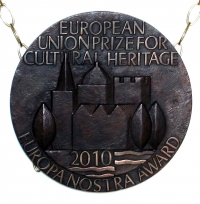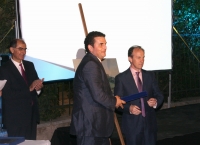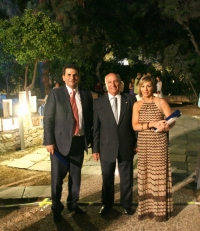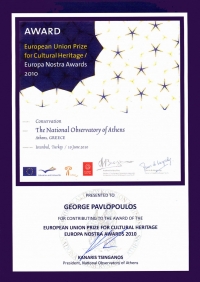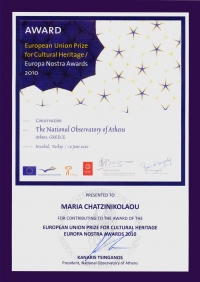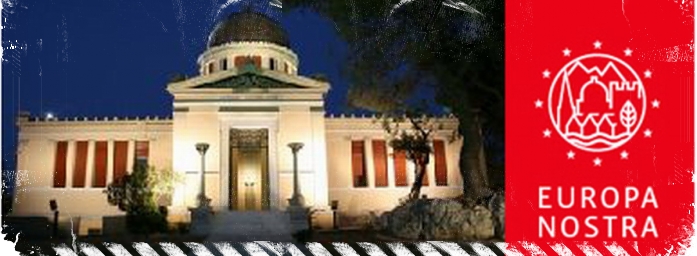
ΒΡΑΒΕΙΟ EUROPA NOSTRA 2010 ΓΙΑ ΤΟ ΕΡΓΟ:ΕΘΝΙΚΟ ΑΣΤΕΡΟΣΚΟΠΕΙΟ ΑΘΗΝΩΝ
Η συντήρηση και αποκατάσταση του διακόσμου του Εθνικού Αστεροσκοπείου Αθηνών, βραβεύτηκε με τo μετάλλειο υποδειγματικής συντήρησης από τη Europa Nostra και την Ευρωπαϊκή Επιτροπή για το 2010. Το βραβείο απονεμήθηκε στις 10 Ιουνίου 2010 στην Κωνσταντινούπολη, που για το 2010 ήταν η Πολιτιστική Πρωτεύουσα της Ευρώπης, στην Αγία Ειρήνη, από την Επίτροπο Πολιτισμού κ. Ανδρούλλα Βασιλείου.
Δεύτερη τελετή απονομής των Βραβείων 2010/2011 European Union Prize for Cultural Heritage / Europa Nostra Awards & 2010 WMO Professor Mariolopoulos Trust Fund Award πραγματοποιήθηκε την Πέμπτη 23 Ιουνίου 2011 στο χώρο του Εθνικού Αστεροσκοπείου Αθηνών.
THE NATURAL, ARCHAEOLOGICAL AND HISTORIC HERITAGE OF THE NATIONAL OBSERVATORY, ATHENS GREECE
Δεύτερη τελετή απονομής των Βραβείων 2010/2011 European Union Prize for Cultural Heritage / Europa Nostra Awards & 2010 WMO Professor Mariolopoulos Trust Fund Award πραγματοποιήθηκε την Πέμπτη 23 Ιουνίου 2011 στο χώρο του Εθνικού Αστεροσκοπείου Αθηνών.
THE NATURAL, ARCHAEOLOGICAL AND HISTORIC HERITAGE OF THE NATIONAL OBSERVATORY, ATHENS GREECE
Category 1 - Conservation
The restoration and conservation of this very important historic complex has been highly commended by the jury. The Observatory is situated in the centre of modern Athens on the ancient hill of the Nymphs. The complex is constituted of four historic buildings designed by the famous European architects Theophil Hansen and Ernst Ziller and a surrounding historic garden. The Observatory has, until recently, maintained its original use as the National Observatory of Greece. The awarded project converted it to a geoastrophysics Museum, which integrally preserves the original equipment (geoatrophysical instruments) as well as a historic library containing hundreds of volumes specialised in geastrophysics, published from the 18th century.
THE GEOASTROPHYSICS MUSEUM AND WALK, NATIONAL OBSERVATORY ATHENS
2010-05-07
C. Zerefos, V. Ganiatsas, S. Zerefos, C. Stavropoulou, E. Nikolaidis, G. Pavlopoulos,
M. Hatzinikolaou, S. Moundrichas, T. Antonakaki, C. Tessas, S. Kourouzidis, A. Metaxatos,
K. Kyritsis
The project aim was the restoration and preservation of most of the historic buildings of the National Observatory Athens (NOA), while at the same time creating an educational geoastrophysical walk linking old and new functions of the restored buildings. More specifically, the elder neoclassical building designed by Theofilos Hansen (c. 1842) was restored to its last detail and transformed into a geoastrophysics museum, exhibiting the instruments used for research that was carried out at the Observatory during its 160 years history of continuous operation. The restoration works were extended to the neighbouring supporting buildings designed by Ernst Ziller, as well as the gardens where the geoastrophysical walk was conceived, designed and implemented. All four neoclassical buildings, plus the walk, are located on the historic hill of the Nymphs, facing the eastern facade of the Parthenon.
The site was a sacred place in antiquity as can be read in an inscription dated c. 5th century B.C. on a rock, next to the entrance of Hansen’s building. Ancient ruins have been found scattered on the hill, as well as a Hellenistic cemetery placing the whole area under the protection and supervision of the Archaeological Authorities of Greece. The observatory hill in Athens, despite its natural, archaeological and historic value, was functioning as a complex of buildings, housing laboratories and offices of research institutes that belong to the National Observatory of Athens. All buildings were in a state of gradual decay, due to usage and neglect for their repair and preservation for more than ten years. The historical building designed by Hansen was used as office space and all historic scientific instruments were neglected, some of them preserved by individual researchers and staff of the Observatory. The whole complex of buildings was inaccessible to the public while the international architectural community had practically forgotten that Ernst Ziller was the designer of three of the buildings. Unfortunately, major alterations were imposed on all historic buildings and all sculptural and painting works were significantly degraded, due to the lack of maintenance, weather conditions and leakages from the roofs of the buildings.
The end result, according to statements by the President of the Hellenic Republic and other eminent visitors, has been outstanding and has even exceeded the original expectations of the design team. The buildings have now been restored, a museum has been created, the main path of the walk has been completed, and the new lighting scheme has reinstated the hill of the Nymphs on the Athens skyline along with the Acropolis, the monument at Fillopappos hill and other landmarks of antiquity, while being able to be visited at night.
The partners involved were architects and technical staff of the National Observatory of Athens, individual architects that did volunteering work for the project, a professional group of restoration experts, as well as museum consultants and research advisors. The design work part of the project involved the design of the restoration of the four buildings, the landscape design of the immediate natural and archaeological context of these buildings, the lighting design of the buildings (interior, exterior), the geoastrophysical walk and the surrounding setting.
The project was implemented within a two year period following five major stages. The first and second stages concerned with the repair of structural defects on the buildings and reinstating the interior decoration respectively. At the third and fourth stage the external works were completed, as well as the interior of the museum and the library. The final stage involved the new lighting scheme and design. More specifically:
1. All necessary structural repairs to the buildings were made, including roof leakages and repairing of interior and exterior plastering. Hansen’s building has been refurbished based on its original plans.
2. Later additions have been removed, destroyed parts have been restored and after major repair and restructuring work all original sculptures and paintings of the ceilings were restored to their original condition. The restored building space has been designed to house the new museum.
3. External works were completed including the placing of new pavement, extensive gardening and the restoration of existing ironwork.
4. The interior design of the museum and the library, including the strategically placed exhibits and volumes, was implemented with a focus on creating a unique user experience that resembles the building usage in the 19th century. Rare astronomical instruments have been restored and are now exhibited in the premises, thus enhancing both the original use of the building and the display of the historical instruments.
5. Completely new lighting design for the Sina building, which can now be identified from a distance, along with other historical landmarks, such as the acropolis and the filloppapos monument, reinstating it on the Athens’ skyline. Similarly, extensive relighting work has been completed for the geoastrophysical walk, as well as the rocks that complete the “Hill of the Nymphs”
The project had many budgetary constraints as available financial resources were limited. Therefore, the architectural studies, the museological study, the restoration of the library and the overall management have been executed voluntarily without any financing. This has provided the appropriate economic environment to overcome the budgetary constraints. For the rest, funding was provided solely from the State Secretary for Research and Technology of the Ministry for Development of Greece in 2006. The management arrangements have been executed by staff working at the National Observatory, Athens (NOA) as well as volunteer architects and curators from other institutions. The overall management was under the President of NOA, who had also the overview of the project.
There are several qualities that make the project outstanding in a European Context. First of all the project was executed at the famous, since antiquity, Hill of the Nymphs, facing the Parthenon. The Hill of the Nymphs, or the observatory hill as is most widely known, is a distinct entity comprising of the natural environment, its worship signs, the presence of a hellenistic cemetery of the classical times and the historic buildings of the National Observatory of Athens. As such, along with the hills of the Pnyx and Fillopappos, it forms a crescent looking towards the Acropolis Hill. So, it responds to its context by being a major reference landmark of the area. Additionally, the geoastrophysical walk connects all 3 entrances to the hill and enhances the interface areas between the urban grid and the hill, while it extends beyond the protective railing of the hill towards being part of the wider paths network which connects all hills to the broader public space and the paths along the foothill of the Acropolis of Athens.
Secondly, close to the 5th century BC observatory by Meton, Hansen’s building hosts optical instruments that were used to make one of the rare handcrafted complete lunar maps by Julius Schmitt (in the 1850s-60s), a map that is also exhibited at the Museum. Other geoastrophysical instruments used by the researchers of the Observatory in its 160-year period of operation are also on display. The total number of exhibits exceeds 200. Notable among them are the first seismographs, filter photometers, meteorological instruments and geodetic equipment used at Napoleon’s expedition in Moreas. The Museum has also a fully restored Library, including hundreds of volumes of Geoastrophysical importance, published between 1700 and 1950. It should be noted here that the main observatory building, designed by Hansen, has been listed as a cultural monument in Greece under FEK54/B.5-3-1952 by the Ministry of Culture. The current administration of the National Observatory of Athens is taking the necessary steps to add the other three buildings by Ernst Ziller to the list of protected monuments in Greece.
Finally, the overall product of the project is used mainly for educational purposes and inspiring cultural events on the Hill of the Nymphs. Future maintenance is ensured in the frame of the operational mode of the services provided to the community by the National Observatory of Athens.
THE GEOASTROPHYSICS MUSEUM AND WALK, NATIONAL OBSERVATORY ATHENS
2010-05-07
C. Zerefos, V. Ganiatsas, S. Zerefos, C. Stavropoulou, E. Nikolaidis, G. Pavlopoulos,
M. Hatzinikolaou, S. Moundrichas, T. Antonakaki, C. Tessas, S. Kourouzidis, A. Metaxatos,
K. Kyritsis
The project aim was the restoration and preservation of most of the historic buildings of the National Observatory Athens (NOA), while at the same time creating an educational geoastrophysical walk linking old and new functions of the restored buildings. More specifically, the elder neoclassical building designed by Theofilos Hansen (c. 1842) was restored to its last detail and transformed into a geoastrophysics museum, exhibiting the instruments used for research that was carried out at the Observatory during its 160 years history of continuous operation. The restoration works were extended to the neighbouring supporting buildings designed by Ernst Ziller, as well as the gardens where the geoastrophysical walk was conceived, designed and implemented. All four neoclassical buildings, plus the walk, are located on the historic hill of the Nymphs, facing the eastern facade of the Parthenon.
The site was a sacred place in antiquity as can be read in an inscription dated c. 5th century B.C. on a rock, next to the entrance of Hansen’s building. Ancient ruins have been found scattered on the hill, as well as a Hellenistic cemetery placing the whole area under the protection and supervision of the Archaeological Authorities of Greece. The observatory hill in Athens, despite its natural, archaeological and historic value, was functioning as a complex of buildings, housing laboratories and offices of research institutes that belong to the National Observatory of Athens. All buildings were in a state of gradual decay, due to usage and neglect for their repair and preservation for more than ten years. The historical building designed by Hansen was used as office space and all historic scientific instruments were neglected, some of them preserved by individual researchers and staff of the Observatory. The whole complex of buildings was inaccessible to the public while the international architectural community had practically forgotten that Ernst Ziller was the designer of three of the buildings. Unfortunately, major alterations were imposed on all historic buildings and all sculptural and painting works were significantly degraded, due to the lack of maintenance, weather conditions and leakages from the roofs of the buildings.
The end result, according to statements by the President of the Hellenic Republic and other eminent visitors, has been outstanding and has even exceeded the original expectations of the design team. The buildings have now been restored, a museum has been created, the main path of the walk has been completed, and the new lighting scheme has reinstated the hill of the Nymphs on the Athens skyline along with the Acropolis, the monument at Fillopappos hill and other landmarks of antiquity, while being able to be visited at night.
The partners involved were architects and technical staff of the National Observatory of Athens, individual architects that did volunteering work for the project, a professional group of restoration experts, as well as museum consultants and research advisors. The design work part of the project involved the design of the restoration of the four buildings, the landscape design of the immediate natural and archaeological context of these buildings, the lighting design of the buildings (interior, exterior), the geoastrophysical walk and the surrounding setting.
The project was implemented within a two year period following five major stages. The first and second stages concerned with the repair of structural defects on the buildings and reinstating the interior decoration respectively. At the third and fourth stage the external works were completed, as well as the interior of the museum and the library. The final stage involved the new lighting scheme and design. More specifically:
1. All necessary structural repairs to the buildings were made, including roof leakages and repairing of interior and exterior plastering. Hansen’s building has been refurbished based on its original plans.
2. Later additions have been removed, destroyed parts have been restored and after major repair and restructuring work all original sculptures and paintings of the ceilings were restored to their original condition. The restored building space has been designed to house the new museum.
3. External works were completed including the placing of new pavement, extensive gardening and the restoration of existing ironwork.
4. The interior design of the museum and the library, including the strategically placed exhibits and volumes, was implemented with a focus on creating a unique user experience that resembles the building usage in the 19th century. Rare astronomical instruments have been restored and are now exhibited in the premises, thus enhancing both the original use of the building and the display of the historical instruments.
5. Completely new lighting design for the Sina building, which can now be identified from a distance, along with other historical landmarks, such as the acropolis and the filloppapos monument, reinstating it on the Athens’ skyline. Similarly, extensive relighting work has been completed for the geoastrophysical walk, as well as the rocks that complete the “Hill of the Nymphs”
The project had many budgetary constraints as available financial resources were limited. Therefore, the architectural studies, the museological study, the restoration of the library and the overall management have been executed voluntarily without any financing. This has provided the appropriate economic environment to overcome the budgetary constraints. For the rest, funding was provided solely from the State Secretary for Research and Technology of the Ministry for Development of Greece in 2006. The management arrangements have been executed by staff working at the National Observatory, Athens (NOA) as well as volunteer architects and curators from other institutions. The overall management was under the President of NOA, who had also the overview of the project.
There are several qualities that make the project outstanding in a European Context. First of all the project was executed at the famous, since antiquity, Hill of the Nymphs, facing the Parthenon. The Hill of the Nymphs, or the observatory hill as is most widely known, is a distinct entity comprising of the natural environment, its worship signs, the presence of a hellenistic cemetery of the classical times and the historic buildings of the National Observatory of Athens. As such, along with the hills of the Pnyx and Fillopappos, it forms a crescent looking towards the Acropolis Hill. So, it responds to its context by being a major reference landmark of the area. Additionally, the geoastrophysical walk connects all 3 entrances to the hill and enhances the interface areas between the urban grid and the hill, while it extends beyond the protective railing of the hill towards being part of the wider paths network which connects all hills to the broader public space and the paths along the foothill of the Acropolis of Athens.
Secondly, close to the 5th century BC observatory by Meton, Hansen’s building hosts optical instruments that were used to make one of the rare handcrafted complete lunar maps by Julius Schmitt (in the 1850s-60s), a map that is also exhibited at the Museum. Other geoastrophysical instruments used by the researchers of the Observatory in its 160-year period of operation are also on display. The total number of exhibits exceeds 200. Notable among them are the first seismographs, filter photometers, meteorological instruments and geodetic equipment used at Napoleon’s expedition in Moreas. The Museum has also a fully restored Library, including hundreds of volumes of Geoastrophysical importance, published between 1700 and 1950. It should be noted here that the main observatory building, designed by Hansen, has been listed as a cultural monument in Greece under FEK54/B.5-3-1952 by the Ministry of Culture. The current administration of the National Observatory of Athens is taking the necessary steps to add the other three buildings by Ernst Ziller to the list of protected monuments in Greece.
Finally, the overall product of the project is used mainly for educational purposes and inspiring cultural events on the Hill of the Nymphs. Future maintenance is ensured in the frame of the operational mode of the services provided to the community by the National Observatory of Athens.
